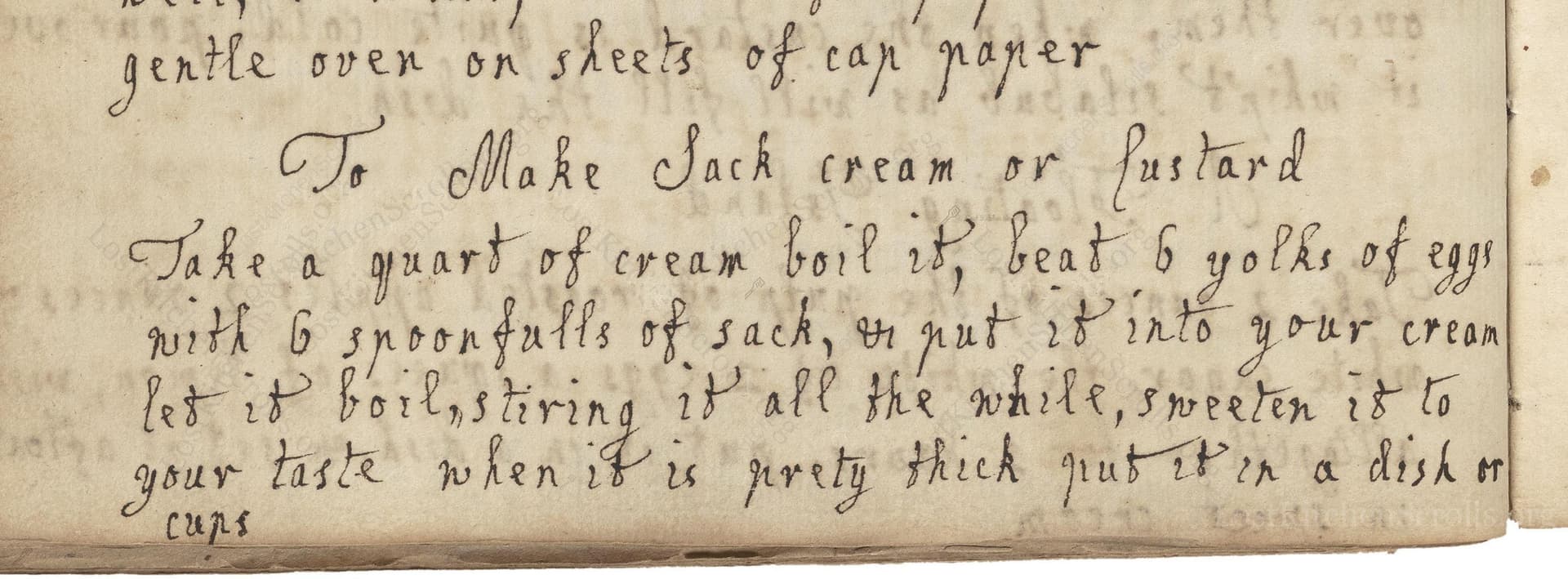To Make Sack Cream Or Custard
From the treasured pages of Cookbook of 1720
Unknown Author

To Make Sack Cream Or Custard
"Take a quart of cream boil it, beat 6 yolks of eggs with 6 spoonfulls of sack, or put it into your cream let it boil, stiring it all the while, sweeten it to your taste when it is prety thick put it in a dish or cups"
Note on the Original Text
Early 18th-century recipes were typically brief and assumed a lot of kitchen experience. Quantities and instructions could be vague ('sweeten to your taste', 'stiring it all the while'). Some terms—such as 'sack,' referring to a type of sherry—are now archaic. Spelling was not standardized ('prety thick'), and punctuation was sparse or inconsistent. Recipes were meant as quick reminders rather than step-by-step guides, presuming the cook’s familiarity with the ingredients and processes.

Title
Cookbook of 1720 (1720)
You can also click the book image above to peruse the original tome
Writer
Unknown
Era
1720
Publisher
Unknown
Background
Step back to the early 18th century and discover a delightful treasury of recipes and culinary secrets, where traditional flavors meet timeless technique—a feast for curious cooks and history lovers alike.
Kindly made available by
Folger Shakespeare Library
This recipe comes from England circa 1720, reflecting the upper-class fascination with rich dairy desserts and luxurious imported liquors like sack (a Spanish sherry). At the time, custard creams flavored with alcohol were fashionable, particularly as part of dessert tables in grand households. The use of sack imbued the cream with a sophisticated aroma and flavor distinct from the plainer creams of earlier centuries.

The recipe would have been made over an open hearth or on a cast-iron stove, using a heavy-bottomed pot or saucepan. Wooden spoons and basic whisks (or bundles of twigs in poorer kitchens) were standard for stirring and blending. A porcelain or pewter dish, or small handled cups, would have been used for serving. Precision thermometers didn’t exist, so cooks relied on careful stirring and the sight and feel of the cream’s thickening to judge doneness.
Prep Time
10 mins
Cook Time
15 mins
Servings
6
We've done our best to adapt this historical recipe for modern kitchens, but some details may still need refinement. We warmly welcome feedback from fellow cooks and culinary historians — your insights support the entire community!
Ingredients
- 1 quart double cream (heavy cream)
- 6 large egg yolks
- 6 tablespoons (about 3 fl oz) dry sherry (substitute: sweet or cream sherry, or use another fortified wine such as Madeira if unavailable)
- Sugar, to taste
Instructions
- Begin by gently heating 1 quart of double cream (heavy cream) in a saucepan.
- In a separate bowl, whisk together 6 large egg yolks with 6 tablespoons (about 3 fluid ounces) of dry sherry (sack, a type of fortified wine popular in the 17th and 18th centuries).
- When the cream is close to simmering, slowly pour a little hot cream into the egg mixture, whisking constantly to temper the yolks.
- Then add the egg and sherry mixture back into the pan with the rest of the cream.
- Return to a medium-low heat and cook, while constantly stirring with a wooden spoon, until the mixture thickens to a custard consistency.
- Remove from heat immediately to prevent curdling.
- Sweeten to taste with sugar.
- Pour the thickened custard into a serving dish or individual cups and allow to cool before serving.
Estimated Calories
480 per serving
Cooking Estimates
It should take about 10 minutes to prepare the ingredients and another 15 minutes to cook the custard. Each serving will have around 480 calories. This recipe makes 6 servings.
As noted above, we have made our best effort to translate and adapt this historical recipe for modern kitchens, taking into account ingredients nowadays, cooking techniques, measurements, and so on. However, historical recipes often contain assumptions that require interpretation.
We'd love for anyone to help improve these adaptations. Community contributions are highly welcome. If you have suggestions, corrections, or cooking tips based on your experience with this recipe, please share them below.
Join the Discussion
Rate This Recipe
Dietary Preference
Main Ingredients
Culinary Technique
Occasions

Den Bockfisch In Einer Fleisch Suppen Zu Kochen
This recipe hails from a German manuscript cookbook compiled in 1696, a time whe...

Die Grieß Nudlen Zumachen
This recipe comes from a rather mysterious manuscript cookbook, penned anonymous...

Ein Boudain
This recipe comes from an anonymous German-language manuscript cookbook from 169...

Ein Gesaltzen Citroni
This recipe, dating from 1696, comes from an extensive anonymous German cookbook...
Browse our complete collection of time-honored recipes



